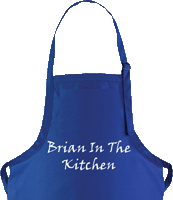Brian in the Kitchen Recipes


BRIAN IN THE KITCHEN brought to you by Stittsworth Meats
April 7 2014
Simple Pan Sauce
Courtesy of reluctantgourmet.com

“If you want to elevate your cooking skills to a new level and up your culinary game, learn how to make a simple pan sauce.”
With this technique in your cooking bag of tricks, you can turn a simple pan-fried steak into a mouth-watering meal, a plain boneless chicken breast into a delicious feast, or a modest pork chop into a scrumptious banquet. Ok, maybe I’m stretching a bit but check this out.
The Pros Do It
Restaurants chefs use this technique all the time. They cook something, usually a protein like meat or fish, in a sauté pan over pretty high heat until it’s done and leaves a bunch of brown caramelized bits of “stuff” in the pan.
You look at this “stuff” in the pan and say to yourself, “Now how am I going to clean this ‘stuff’ off the pan? What a mess! I wish I used a non stick pan.” Before you reach for your green scrubby pad, keep reading.
Fond, What Is It & What Is It Good For?
The “stuff” has a name, it’s called “fond” and you want that “fond” stuck to your saute pan because it is packed with incredible flavors. It’s also easy to remove by adding a little liquid to the pan and using a wooden spoon to dissolve it. This is called deglazing and can be done with wine, brandy, fortified wines, stock, cider, fruit juices or most typically a combination of two. Just be careful if you use wine, to remove the pan from the heat so the alcohol doesn’t ignite and blow up in your face. I’ve spoken with chefs who have seen this happen.
The next steps are to reduce the liquid in the pan and add several pats of butter to thicken and enhance the flavor of the sauce. If you ever knew how much butter professional chefs use in restaurants to “enhance” flavor, you would be amazed. I sometimes think they make their dishes too rich because I can feel it when I get home, but then again, it’s so good when you’re eating it. It makes sense, though. Fats not only give foods wonderful body, they also carry a lot of flavor.
Now those are just the basics. To create some more complexity to the sauce you’ll want to add some aromatics like garlic or shallots for a subtle but additional layer of flavor. Then you might want to add some additional ingredients such as mushrooms, mustards, chutneys, herbs and/or spices to give even more complexity and flavor.
This is how many of the classic sauces with all the fancy French names are made. By adding different ingredients to stock reductions, you can create the same sauces at home. Depending on the level you want to take it to, it can be quick and easy or a little more time consuming and complex. But no matter which way you decide to go, you will end up with a more incredible, flavorful, delicious result than if you didn’t make the sauce at all.
The Right Pan
As I mentioned above, you want the caramelized brown “stuff” to stick to the pan. So it wouldn’t make any sense to use a pan with a non stick surface. That only defeats the goal of creating that wonderful flavored fond. I have also read that you should stay away from cast iron pans because the iron reacts to food high in acid like red wine and gives off a metallic taste. Although I love cooking foods in my cast iron skillet, stay away if you are planning to make a pan sauce.
The best pan for sautéing and making a pan sauce therefore would be a heavy bottomed, non reactive sauté pan. I happen to like Caphalon pans but there are so many good ones out there these days including All Clad and Viking. Check out How to Choose a Good Saute Pan to learn more about them and what’s available on the market.
What about the size of the pan? Whenever you are sautéing anything you want to make sure you give the meat, chicken, or fish enough room in the pan to allow it to sear and to prevent steaming. Rule of thumb is leave at least 1/4 to 1/2 inch between pieces. On the other hand, you don’t want a pan that’s too big or the ingredients have a tendency to burn. I have a 10 inch, 3 quart Caphalon sauté pan that works great for my family cooking
Stock Reductions
Another challenge you are going to face as a home cook is finding good stock to make the sauces. The canned beef stock or chicken stockyou find in your grocery store doesn’t cut it. Nor do the powdered products that you find all over your supermarket shelves that are nothing more that powdered corn starch and salt. And please don’t even think about using a bouillon cube.
Check out my article called Making Incredible Sauces At Home where I list some ways to obtain good quality stock and stock reductions. Also check out my Stock Reductions where I list the best source for quality stock reductions including demi glace, lobster stock, lamb stock, etc.
Sautéing
A really important technique for making quick and delicious pan sauces is sautéing. In my opinion, it all starts there. Please check my How to Sauté page to explore how to sauté properly. Once you learn how to sauté, you will not only be able to cook meat, fish, and chicken to perfection, but also make delicious pan sauces to go with them.
Depending on how much time you have on your hands or how involved you want to get, you can make a quick simple pan sauce or a classic pan sauce with all the additional layers of flavor.
How Much Liquid?
Most of the time I start with a half a cup of wine and half a cup of stock and reduce them both by half. That’s just a general rule of thumb because what I’m really looking for is a certain desired thickness when the sauce is done. A better gauge to tell when the sauce is thick enough is when it coats a metal spoon. Yes, I love cooking with wooden spoons, but in this case you want to use a metal spoon.
Depending on the other ingredients you add to the sauce including butter, mushrooms, cream, etc., the reduction ratio will differ. As always in cooking, it just takes a little practice and you will get comfortable with your amounts. It also pays to remember that, if you are cooking for your family, you need to cook to their taste. Since nobody knows your family’s taste better than you, you are in control of how much you reduce your sauce. The more you reduce a sauce, the more intense it will be. You are in the driver’s seat.
Classic Pan Sauces Vs Quick Pan Sauces
The difference is simple. A simple pan sauce gets its flavor from deglazing the pan with your liquid(s) once the meat has been removed, reducing the liquids by a least half and adding butter to thicken and add flavor. A classic pan sauce will follow the same steps but will add more complexity by adding other ingredients throughout the process.
I prefer taking the longer route because the added step to add some shallots or garlic doesn’t take that much time maybe another 3 – 4 minutes. To add some mushrooms while the sauce is reducing isn’t going to increase the total cooking time that much either. If you really need to speed up the process, you can always decrease the amount of deglazing liquid but this will also decrease the richness of the sauce.
Then there are the nights when I just don’t have the time or energy to go the extra distance so I take some shortcuts and make a quick pan sauce. It still tastes great and is better than no sauce at all.
For two example recipes for the same sauce, one classic and the other quick check out Red Wine Pan Sauce
Making a Simple Pan Sauce, Step by Step
- Sauté your protein of choice until done. Remove from the pan and keep warm.
- Turn the heat to medium high, and deglaze with a flavorful liquid, scraping the pan with a spoon to dissolve all the fond. Reduce by at least 1/3, to taste.
- When the reduction is a bit syrupy, remove from the heat.
- Taste and add salt and pepper, if necessary.
- Swirl in a pat of butter or a splash of cream to finish the sauce, round out the flavors and give it some added body.
Since pan sauces can be intensely flavored, you really only need one or two tablespoons per serving. So, to make a pan sauce for a family of four, you will only need about 1/2 cup of sauce.
Variations
- In Step 2, add a little fat and sauté some minced shallot or garlic until softened and just starting to brown before deglazing.
- In Step 2, add minced, sliced or diced mushrooms along with the shallot or garlic.
- In Step 2, stir in some mustard, chutney or other flavor accent
- In Step 4, stir in some fresh minced herbs.
Of course, the trick is to use complementary flavors. To make an Italian-inspired pan sauce, you might use a mixture of stock and Chianti, perhaps stir in some tomato paste along with some garlic, flavor it with basil and/or oregano and finish the sauce with some olive oil.
For a French twist, consider adding minced shallot, stirring in some Dijon mustard, using stock and white wine for the deglazing liquid and flavoring with some tarragon, lavender or Herbes de Provence.
You can even make a great sauce with Asian flavors by sautéing some fresh ginger and stirring in some peanut butter in Step 2, flavoring with some five spice powder and deglazing with a lemony chicken stock. Finish the sauce with some toasted sesame oil.
Remember, a quick pan sauce is about using a series of techniques—sauteing, deglazing, reducing and enriching—and not so much about following a strict recipe.